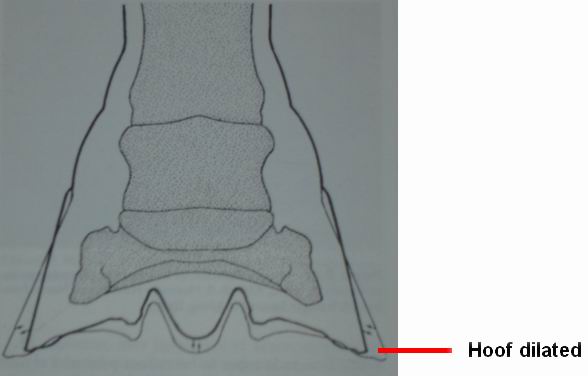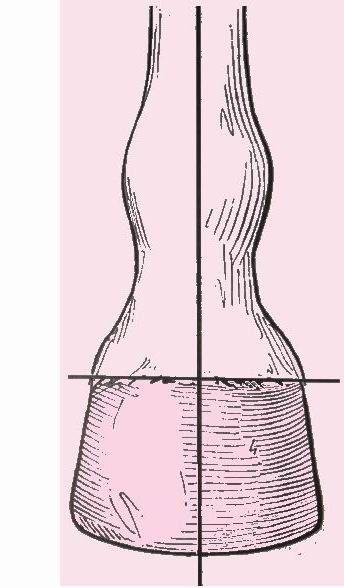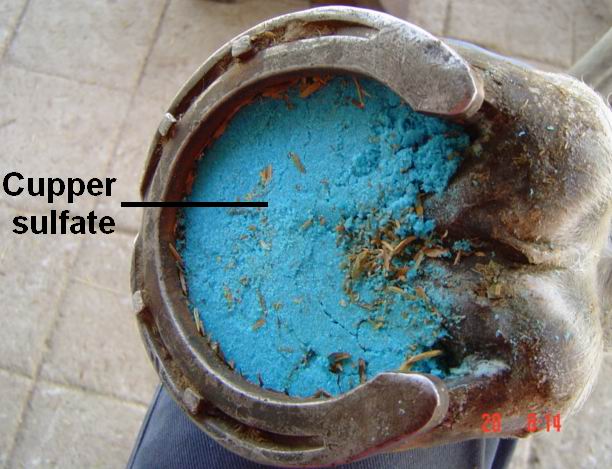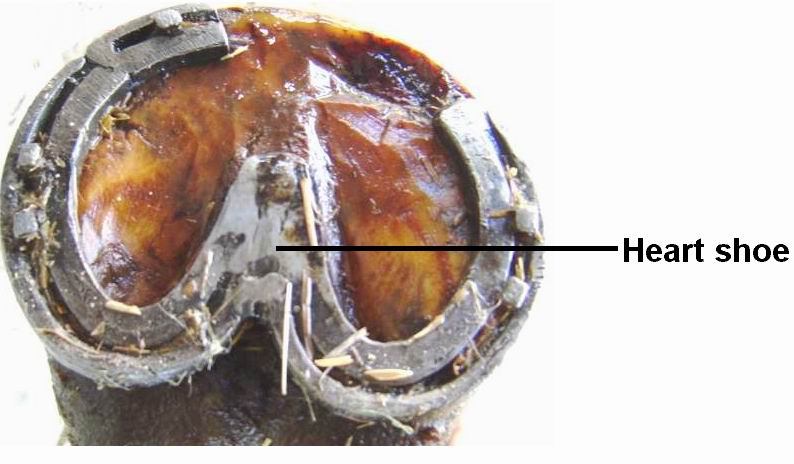|
|
Churo Pelligrini has provided a brief summary and introduction to polo players about some of the veterinary problems that occur in horses that play polo. |
Veterinary Advice for Polo Horses
|
|
Churo Pelligrini has provided a brief summary and introduction to polo players about some of the veterinary problems that occur in horses that play polo. |
| Basic Anatomy of the
Foot When the foot makes contact with the ground, it expands reducing the impact and allowing the entrance of blood to the internal structures. And when it is not in contact, it constrains, helping to the expulsion of the blood. This is what many people call to horse “the five heart animal.” The palmary surface of the hoof must be concave, because it helps to reduce the impact. The shoe cannot avoid this normal function because it will reduce the circulation and produce lameness, and disease. Remember that the polo shoe have 8 holes for nails, but the last two, is better not to use, because same times reduce the capacity of expansion of the hooves.  Note the concave of the palmary. |
|
| Balance of the hoof In the frontal view of the foot, the normal one must be straight (A imaginary line must cut the fetlock joint and the hoof in two same parts), so all the structures receive the same pressure. |
 |
The normal angles of the hoof
are: - 53-58 degrees for the front legs. - 55-60 degrees for the back legs. |
|
| In the lateral view the angle of the hoof must be parallel to the imaginary line of the second and third phalange. |
|
| What happens if the angle is inferior: (the back surface of the hoof is reduce) Here the deep flexor tendon, and the ligaments are receiving more tension that the normal one, so you can help to produce an inflammation on this structure (tendonitis). If you don’t correct the angle, the Navicular bone, and the distal interphalangic joint, can get degenerative, and irreversible changes, this problem can produce a retire of activity in sport horse. The hoof needs more time to begin the step, this produce, that the back legs traumatize the front ones. (see auto contusions). And also the wall can fracture easily, because the pressure is not the same in the front and in the back surface of the hoof. Solution: Put shoes with supplement (aluminous), or plastic pads, to recover the normal angle of the hoof. |
|
| What happens if the angle is
superior: (the front surface of the hoof is reduce). Here the deep flexor tendon is relax, so the pressure is increase in the superficial flexor tendon, and in the digital extensor tendon, so they will get a possible inflammation, if the farrier doesn’t correct the hoof. Also the interfalangic joint changes the position, and the correct angle, this reduce the functionality, and the pressure into the joint will be increased, taking to degenerative changes that showed lameness. Solution: Correct the balance of the hoof with a “Rasp”, and control the normal angle. “The way to correct a hoof, and shod are
vary important on the performance and the health of the horse.” |
| Why shoe the polo horses? |
|
|
Basic things to know about shoeing.
|
 Note that the internal side its
higher, that gives the possibility of quick movements, and more adherences to
the field Note that the internal side its
higher, that gives the possibility of quick movements, and more adherences to
the field |
|
|
|
|
|
|
| Fractures This is a common problem, in polo horses, and produce lameness, because the hoof is open and can get infections, and same times the fracture contact the sensitive tissue of the hoof. The hoof is an elastic tissue, but when it became dry reduces the flexibility, and when it is very humid can be more flexible, and brakes. There are 2 kinds of fractures, the horizontal (blow-out), and the vertical ones. Remember that the hoof cannot cicatrize, so is important to control the fracture and try to stop it. Same times the fracture is so big and the hoof needs to be stuffed with synthetics products, as glass fiber, or elastic plastic. Solutions: In both fractures the hoof must be waste in the part that the fracture goes, so it will not receive pressure, and the fracture line will not increase. |
| Horizontal fractures: The horse need to be shod, the shoe and the hoof must be waste on the part that the fracture goes (following the facture line), this is important because any part of the fracture will not receive pressure. |
|
| Vertical fractures: The same as horizontal fractures, wasting the hoof and the shoe is important, and also here you can use suture to control it. (Only in the deep fracture). If the fracture is superficial the farrier can waste the wall of the hoof, so the pressure will be distributed in many directions, helping to stop the fracture line (Pictures). |
|
|
|
A- Plastic (reduce the mobility of the
fracture line) B- Fracture line C- Hoof fixers (to reduce the expansion of the hoof) D- Hoof and shoe waste |
| Abscess in the hoof This is very common problem on horses. This year we have many problems in “Saraburi”, because the paddocks were too wet, so the hoof became soft, easy to break and get infections. Symptoms: The horse is so painful, and some times they refuse to walk. The hoof increases the temperature because of the inflammation and infection, and also the digital pulse is increase. Solution: Open the abscess, and take out the dirty. The use of astringent substances as “copper sulfate” helps to take out the liquid, from the inflammation because it produces pain due the increase of the pressure inside the hoof. You can use it diluted in warm water, or topically. In the last case the farrier can use a shoe with a plastic, so the palmary surface is not in contact with the floor, and this also permits to put the “copper sulfate”. Is important to put a bandage around the shoe to avoid the lost of the medicine. |
Others medicaments:
Advantages of using the plastic:
|
  24 hours after the administration of cupper sulfate. |
| Deviated hoof This is a problem on “Cachamay”, on the left front leg. Here the lateral faces of the hoof don’t have the same directions. Symptoms: Normally don’t have any one, but can produce lameness when the horse is in training, because the ligaments of the interfalangic joints receive over weigh. Solution: The farrier can put a shoe following the normal direction of the hoof, so in one side the shoe will go outside the hoof, and in the other side the shoe will be smaller than the hoof. |
|
| Cartilage ossification Inside the hoof there are two cartilages that helps to reduce the impact (shocks), when they became bones, cannot complete their function causing lesions up in the leg (mainly in joints and bones). This is a problem in “Camperita” on the right front leg. Symptoms: The horses begin to have deformations on the bones and joints, and also pain (lameness). Treatment: Is necessary for the foot to have a shocks function, but is not possible to recover the cartilage, so the farrier must use plastic pads, so they will absorb pressure reducing the tension in bones and joints. |
|
| Auto contusions Problem: The back legs can hit the frontal ones, or in the other way also. Sometimes the hoof is to long in the front legs, so this increase the time to start the step, and make the back hoof contact with the frontal, and hurt the flexor tendons, hoof, ligaments and also bones. The rider can hear a noise when the horse is training, that comes from the hit of the hooves. The horse can have same injures in the place that the hooves hit. This is a problem in “Pitufa.” Solution: Some times when the frontal hooves are too long, the step starts later, so the hind legs contact the frontals, the solution here is just to correct the frontal hooves. But some times the problem is not the long hooves, so the farrier have others alternatives to control the problem as:
|
|
| Foot of mule This is a problem in the left front leg of “La Novia”. The checks of the foot, are too close each other (mule’s hoof), so the hoof has less flexibility, and the affects also the sanguine irrigation. Symptoms: It can produce lameness but is not common. Solution: Increase the humidity into the hoof, it will became soft, and more flexible, helping the dilatation and the internal sanguine circulation. The furrier can use Vaseline or Paraphine topically. The shoe must be beveled toward out only in the back side before the last nail hole. This helps to recover the normal position of the hoof, but its take time, to recover he normal structure. |
|
Laminitis Is a pathology that produces a rotation on the “third phalange”. It's more common in the front legs, but it can be in the back legs. There are many things that can produce this disease for example: - High levels of carbohydrates (pellets-corn-trenches) - Colic - Endotoxemia - Placenta retention Symptoms: The horse can not walk because of the pain, its common to find them laying on the floor, or standing with a typical posture (figure). No Cure: Most of the horses with laminitis are put down because of the symptoms, and it also a very painful disease. Laminitis cannot be cured, but is important to control the rotation of the third phalange, so the furrier can use a special kind of shoe “heart shoe”. |
|
 |
This shoe gives a support to the third phalange, helping to prevent the rotation. When the third phalange is stable, so it cannot rotate any more, the farrier can waste the hoof following the direction of the third phalange, (X-ray), so the structures can return the normal position. |
|
|
Note that the third phalange must be parallel to the wall. |
|
| Contusion of the third phalange This is a problem in "Vision, Pampero and Naranja." When the palmary surface of the hoof is flat, all the pressure is transmit to the third phalange, and some times produce, inflammation and pain in the hoof. And also when the shoe is too wide, produces the same, because there are parts of the hoof that cannot receive pressure. Symptoms: The horse is lame, and painful in the hoof (hoof test) and around the shoulder also. All the distal problems produce pain at proximal. Solution: The normal palmary surface must be concave, so the furrier should correct it. Here is important to use plastic pads, between the hoof and the shoe, so they will reduce the pressure of the third phalange. In this horses the shod must be each 20-25 days. |
|
|
Colic Colic means acute pain in the abdominal cavity, but it is related with the digestive system of the horse. It is a common problem on “in doors” horses. There are many causes of colic the more common are: • Obstruction in the digestive tube • Torsion of the digestive tube • Spasmodic • Parasites (S.vulgaris, Gasterophilos spp, etc) • Changes in the diet • Excessive accumulation of gas • Sand in the digestive tube. Important things to know abut the history of the horse. • Edge • Food (changes, times, quality and quantity of feeding) • The horse goes to paddocks? • The horse eats the bedding/wood? • Worms control The common symptoms of the horse are: • Uneasiness and excessive perspiration • The horse roll on the floor frequently • Hits the floor with the front legs • Turn the neck to observes his abdomen repeated times • Acquires the position to urinate or to defecate, without getting it • The horse kicks the abdomen cavity. Remember: • Foals are vary sensible to the pain • The small intestine, has a reduce possibility of expansion, so when the problem is here the symptoms are increased. What you can do before the vet arrives. Is important to send the horse to walk and don’t give water or food. You can use a stomach tube, (the horse can not vomit) this helps to reduce the pressure into the stomach, because it can only support 10-15 liters, and many times the duodenal contains goes into the stomach, causing the rupture of the organ, and peritonitis (bad prognosis). Is important not to prescribe the horse before is revised by a vet, because important signs can be disguise. Control the breathing, heart frequency, the temperature and the intestinal movements, this data are of supreme importance for the vet. The normal color of the mouth and ocular membranes must be pink pale. Same times they became more plaids (indicating dehydration/anemia), or brilliant red (indicating endotoxemia). Same times when a horse have a colic, the motility of the digestive tube is avoid, so many toxins of the intestinal contains goes into the circulatory system (endotoxhemia), and trough all the body, causing many problems as laminitis, abortion in pregnant mares, disseminated coagulation, etc. The Vet is the only one that should treat the horse, after a complete audit. The secret is to know how to prevent the colic. About the food: The horses need to eat fiber (grass-straw-hay), this helps to stimulate the motility, and a good function of the digestive tube. Is important that the horses have the possibility to eat fiber during all the day. All the changes need time, because the normal intestinal flora needs to adequate to the new feed. When the food will be change, is important to increase the eating of fiber to reduce problems of colic, or diarrheas. Is important to feed the horses with balanced food at the same time every day, so they get used to a schedule of food. About the water: It must be fresh and clean, the horses need to drink water during all the day. About the paddocks: The horses in the natural life are eating grass, and walking for many hours each day, and is not vary frequently to them to get colic’s, this indicates, that walking helps to the normal motility of the intestinal tube. The paddocks help also to prevent the “bad habits” as eating the bedding, air, etc. When the horses are sent to paddocks they can eat sand, to control the content of sand in the defecations every month, is so important, and vary simple. Worms: It’s very important in horses not only in foals, remember that many worms can cause colic. You can check the eggs in the defecations, and have an idea abut the quantity and quality of worms. |
|
|